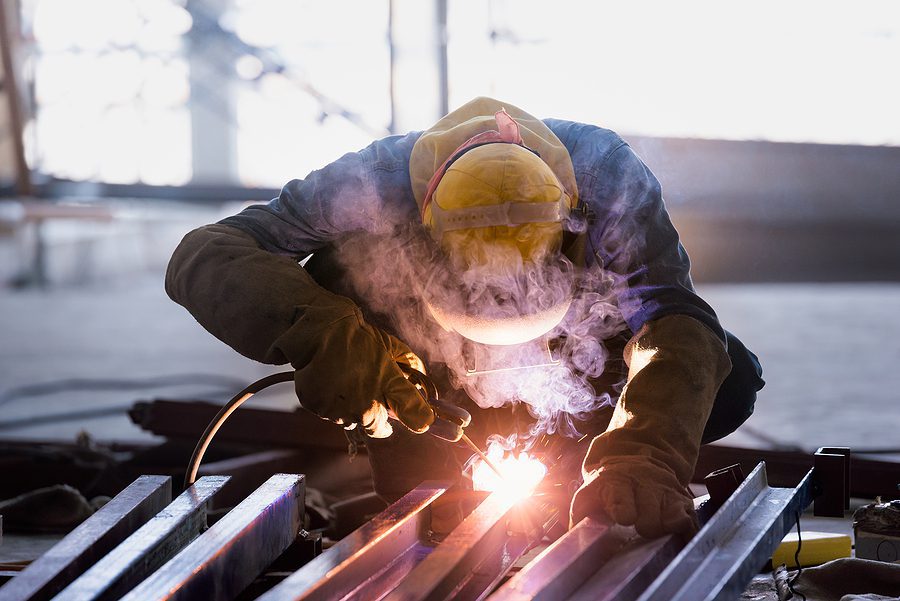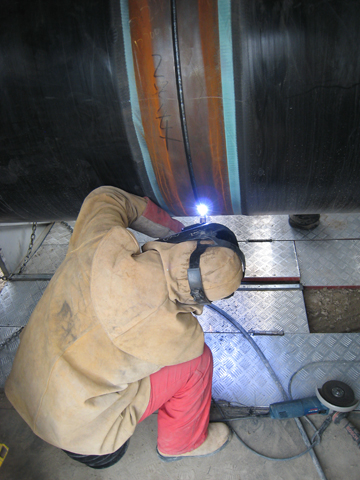Usual Welding Repair Issues and Exactly How to Address Them Successfully
Welding fixings frequently encounter a variety of concerns that can endanger the honesty of the final item. Usual problems include insufficient infiltration, porosity, and imbalance, amongst others. Each problem presents distinct obstacles that require specific methods for resolution. Comprehending these issues is necessary for welders intending to enhance their skills and end results. This conversation will certainly explore these common welding repair work concerns and efficient techniques to resolve them.
Inadequate Infiltration
Insufficient penetration takes place when the weld metal fails to fully fuse with the base product, causing weak joints and prospective structural failings. This problem usually comes from insufficient warmth input, wrong electrode angle, or incorrect welding rate. Welders might run into inadequate penetration as a result of a miscalculation of the required criteria for a certain material thickness or type. In addition, contamination on the base product's surface area can hinder reliable bonding, aggravating the issue. To deal with poor infiltration, welders ought to ensure appropriate setups on their equipment and keep a clean work surface. Routine examination of welds is suggested to recognize any type of shortages early, permitting timely adjustments and the avoidance of endangered structural stability in bonded settings up.
Porosity
Porosity is an usual flaw in welded joints that manifests as little gas bubbles caught within the weld metal. This problem can compromise the integrity of the weld, bring about decreased stamina and prospective failure under tension. Montana Mobile Welding and Repair Belgrade Welding. Porosity normally emerges from contamination, moisture, or incorrect welding strategies, which permit gases to leave into the molten weld swimming pool. To resolve porosity, welders should ensure correct surface area prep work, maintain a clean working environment, and utilize appropriate welding specifications. Furthermore, picking the right filler material and securing gas can minimize gas entrapment. Regular evaluation and testing of welds can aid recognize porosity early, guaranteeing timely rehabilitative activities are taken, thus preserving the quality and integrity of the welded framework
Imbalance
Imbalance in welding can develop from different variables, consisting of inappropriate arrangement and thermal development. Comprehending the source is necessary for reliable resolution. A number of improvement methods are readily available to straighten elements and guarantee structural honesty.
Reasons for Misalignment
Welding misalignment frequently originates from a range of underlying issues that can endanger structural honesty. One primary cause is inappropriate fit-up of elements prior to welding, which can bring about gaps and unequal surfaces. Variations in thermal development throughout the welding process can additionally cause distortion, especially if the products being signed up with have various coefficients of growth. In addition, inadequate fixturing and clamping might stop working to hold parts securely in position, leading to activity during welding. Badly maintained equipment, including welding makers and tools, may present incongruities in the weld bead, additional adding to misalignment. Finally, driver error, coming from inadequate training or experience, can additionally play a considerable role in developing misaligned welds.
Modification Methods Available
Dealing with imbalance successfully needs a mix of restorative methods customized to the particular issues at hand. One usual approach is the usage of components or jigs to hold elements in the right position throughout welding, making certain consistent placement. In addition, preheating the products can aid lower distortion and enhance fit-up. For significant misalignment, mechanical adjustment methods, such as utilizing hydraulic jacks or clamps, can be employed to fix the setting before welding. Post-weld warm treatment might likewise be needed to soothe stresses brought on by misalignment. Careful evaluation and modification throughout the configuration phase can prevent imbalance problems from coming to be considerable problems, advertising a smoother welding process and improving total architectural stability.
Distortion
Distortion is an usual obstacle in welding that can develop from numerous variables, consisting of uneven heating & cooling. Recognizing the reasons for distortion is necessary for carrying out reliable avoidance methods. Resolving this issue not just improves architectural honesty yet additionally boosts the total top quality of the weld.
Reasons for Distortion
When subjected to the extreme warmth of welding, products typically go through changes that can result in distortion. This sensation mostly occurs from thermal growth and contraction throughout the welding procedure. As the weld area warms up, the material expands; upon cooling, it acquires, which can develop internal tensions. On top of that, unequal heating eltham welding throughout a workpiece can intensify these tensions, resulting in warping or flexing. The kind of product likewise plays a significant role; steels with varying thermal conductivity and coefficients of growth might react in different ways, bring about uncertain distortions. Poor joint design and poor fixturing can add to misalignment during welding, increasing the probability of distortion. Comprehending these reasons is important for effective welding repair and prevention methods.
Avoidance Techniques
Efficient prevention strategies for distortion throughout welding focus on regulating warmth input and ensuring proper joint style. Maintaining a constant heat input assists to reduce thermal growth and tightening, which can result in distortion. Utilizing techniques such as pre-heating the work surface can likewise reduce the temperature gradient, advertising consistent heating. In addition, picking appropriate joint layouts, such as T-joints or lap joints, can improve stability and minimize stress focus. Executing appropriate fixturing to secure the work surfaces in area better help in keeping placement throughout the welding process. Staggered welding series can distribute heat much more uniformly, protecting against localized distortion. By using these methods, welders can considerably reduce the probability of distortion and enhance the total top quality of their welds.
Cracking
Breaking is a common concern run into in welding repair services, typically resulting from various elements such as improper air conditioning prices, product selection, or poor joint prep work. The event of fractures can substantially endanger the integrity of the weld, resulting in possible failures during operation. To address this concern, welders need to first evaluate the source, ensuring that materials are suitable and suitably selected for the specific application. In addition, regulating the air conditioning rate during the welding process is necessary; fast cooling can generate tension and bring about fracturing. Correct joint style and prep work additionally add to lessening the danger. Implementing these approaches can improve weld quality and this page sturdiness, ultimately decreasing the chance of fracturing in ended up weldments.

Insufficient Blend
A significant issue in welding repair services is incomplete fusion, which happens when the weld metal does not sufficiently bond with the base product or previous weld passes - Montana Mobile Welding and Repair. This flaw can cause weak points in the joint, potentially endangering the honesty of the welded structure. Variables adding to incomplete fusion include not enough heat input, incorrect welding technique, and contamination of the surface areas being joined. To address this problem successfully, welders need to assure appropriate pre-weld cleansing and surface prep work, along with adjust their welding criteria to achieve appropriate infiltration and fusion. Regular assessment throughout the welding procedure can additionally aid determine incomplete combination early, enabling prompt restorative procedures to boost the overall high quality of the weld
Overheating
While welding repairs can enhance structural integrity, overheating presents a considerable challenge that can lead to material degradation. Excessive heat throughout welding can modify the mechanical homes of metals, leading to minimized toughness, boosted brittleness, and bending. This phenomenon is particularly critical in high-stress applications where architectural integrity is paramount. Recognizing overheating can include aesthetic inspections for discoloration or distortion, as well as keeping an eye on temperature level throughout the welding procedure. To mitigate the risks connected with overheating, welders should use suitable methods, such as regulating warmth input, readjusting traveling rate, and using ideal filler materials. In addition, executing pre- and post-weld warmth treatments can aid restore material properties and boost the general high quality of the repair service, guaranteeing long-term efficiency and security.
Often Asked Concerns
What Are the Typical Indications of a Welding Flaw?

How Can I Examine My Welds for Top quality?
To evaluate welds for high quality, one can make use of visual assessments, ultrasonic screening, and radiographic approaches. Each method ensures architectural stability, determines issues, and validates adherence to defined requirements, eventually enhancing the dependability of the bonded joints.
What Safety and security Preventative Measures Should I Take While Welding?
When welding, one must focus on security by wearing ideal individual safety equipment, guaranteeing proper ventilation, safeguarding combustible materials away, keeping a tidy office, and understanding surroundings to protect against injuries and crashes.
Can I Repair a Weld Without Remodeling the Entire Joint?
Repairing a weld without redesigning the entire joint is feasible, depending on the damage (Montana Mobile Welding and Repair). Techniques such as grinding, adding filler product, or utilizing a welding process can efficiently address details problems while protecting the surrounding framework
What Equipment Are Important for Effective Welding Fixes?
Vital tools for efficient welding repair work consist of a welding device, cord brush, grinder, safety gear, clamps, and filler products. Each tool plays a vital duty in making sure quality and safety and security throughout the repair work procedure. Porosity usually develops from contamination, dampness, or incorrect welding strategies, which permit gases to get away into the liquified weld pool. Improperly kept tools, including welding makers and devices, might present inconsistencies in the weld bead, further contributing to view misalignment. When subjected to the intense warm of welding, materials often undergo modifications that can lead to distortion. Fracturing is a common concern experienced in welding repair services, frequently resulting from different variables such as improper air conditioning rates, material choice, or poor joint prep work. A significant concern in welding repairs is insufficient combination, which occurs when the weld steel does not adequately bond with the base material or previous weld passes.